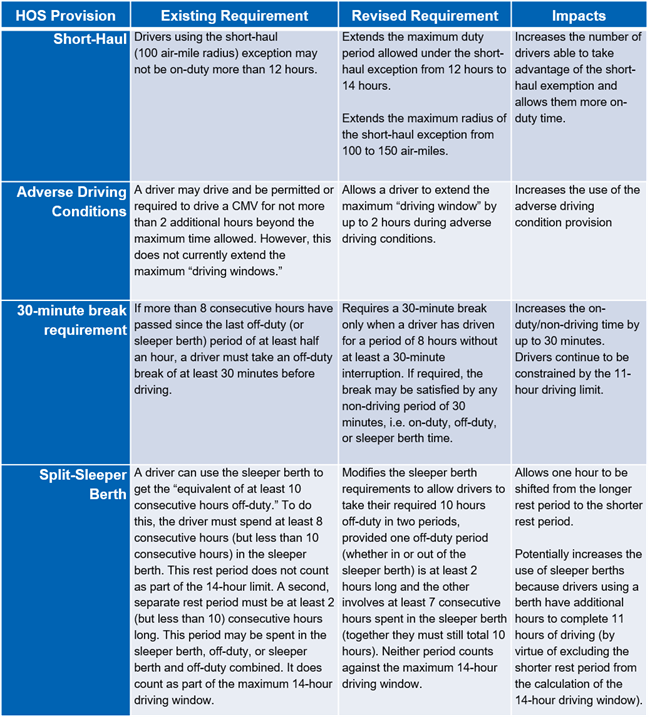June 3, 2020
US Department of Transportation Adjusts 'Hours of Service Rule' for Truckers
Contents
Volume 14, Issue 6
June 2020
Click here for a PDF version of this month's issue.
US Department of Transportation Adjusts ‘Hours of Service’ Rule for Truckers
The U.S. has long had many regulations to ensure that trucks travel our roads safely. However, it seems that in recent years, the level of complexity of these regulations has dramatically increased. While farm, forest and fishing businesses are not primarily in the trucking business, they still operate commercial vehicles and therefore must comply with the same laws and rules as transportation companies with large truck fleets.
The Federal Motor Carrier Safety Administration (FMCSA) was established within the U.S. Department of Transportation in 2000, pursuant to the Motor Carrier Safety Improvement Act of 1999. The FMCSA, as it is known, has a mission to prevent commercial motor vehicle-related fatalities and injuries, and to support the development of unified motor carrier safety requirements and procedures throughout North America.
The breadth of regulations administered by the FMCSA go far beyond what can be covered in this article, but a significant set of rules apply to “hours of service” (HOS), which relates to the number of hours per week that a driver is allowed to work in order to avoid fatigue-related accidents. Currently, if a driver of a commercial vehicle (which is not the same as a vehicle requiring a commercial driver’s license), travels beyond a 100-air-mile radius of their home location, they must comply with HOS regulations. Perhaps the most significant rule change is that this exemption will be extended to a 150-air mile radius.
The following types of vehicles are considered commercial vehicles:
- Vehicles with a gross vehicle weight rating (GVW), or gross combination weight rating, or gross weight, or gross combination weight of more than 10,000 pounds
- Vehicles designed to transport more than 15 passengers1
- Vehicles transporting hazardous materials in a quantity requiring placards, regardless of the GVW
The Department of Transportation has had HOS rules since 1937. These rules have been revised over the years, with the most recent revision occurring in late 2019.
Based on public comments and input received from commercial drivers, operators and other industry experts, FMCSA’s final rule on hours of service offers four key revisions to the existing HOS rules:
- The agency will increase safety and flexibility for the 30-minute break rule by requiring a break after 8 hours of consecutive driving and allowing the break to be satisfied by a driver using on-duty, not driving status, rather than off-duty status.
- The agency will modify the sleeper-berth exception to allow drivers to split their required 10 hours off duty into two periods: utilizing either an 8/2-hour split or a 7/3 hour split with neither period counting against the driver’s 14‑hour driving window. Previously the two hours out of the sleeper berth counted against the 14-hour window.
- The agency will modify the adverse driving conditions exception by extending by two hours the maximum window during which driving is permitted.
- The agency will change the short-haul exception available to certain commercial drivers by lengthening the driver’s maximum on‑duty period from 12 to 14 hours and extending the distance limit within which the driver may operate from 100 air miles to 150 air miles.
FMCSA estimates that these modifications will result in savings for operators and business owners, and states that the final rule will provide the needed time for operators to keep trucks on the road, keeping the U.S. food and goods supply open and operating safely to meet the growing demand of the U.S. consumer. This new final rule will go into effect in mid-September 2020.
Here is a summary of the hours of service rules before and after the change (for property carrying drivers).2
In addition to the HOS changes listed above, which apply to truckers of all types, agricultural haulers have some additional exemptions, which remain in place, including:
- Haulers of livestock or insects are exempt from the 30-minute break requirement after 8 hours of driving.
- Haulers of “agricultural commodities” only need to count their hours-of-service for the portion of their trip when they are outside the 150 air-mile radius. Hours driven within that radius, or after returning to that radius are not counted, effectively extending their on-duty availability.3
Links for More Information
The Agricultural Commodity Exception to the Hours of Service Regulations
Exemptions to the Federal Motor Carrier Safety Regulations
Final Rule Document from Dept of Transportation-FMCSA
DOT FMCSA Press Release
1 If passengers are transported for compensation, the limit is 8.
2 The HOS rules are slightly different for passenger-carrying drivers.
3 See the Agricultural Commodity Exception to the Hours of Service Regulations for more information.
Editor: Chris Laughton
Contributors: Christopher Wolf, Tom Cosgrove, Kyle Bell and Chris Laughton
View previous editions of the KEP
Farm Credit East Disclaimer: The information provided in this communication/newsletter is not intended to be investment, tax, or legal advice and should not be relied upon by recipients for such purposes. Farm Credit East does not make any representation or warranty regarding the content, and disclaims any responsibility for the information, materials, third-party opinions, and data included in this report. In no event will Farm Credit East be liable for any decision made or actions taken by any person or persons relying on the information contained in this report.




